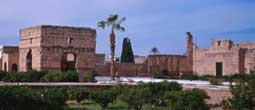|
The
Al Badii Palace is of great importance in the history of Marrakesh. The
Badii Palace plays a special role in the evolution of architecture and
garden art in Morocco. It was built by Ahmed al-Mansour, the greatest
of the Saadian sultans in 1594, and was probably completed around 1603,
the year of his death. It remained the reception and entertainment Palace
of the Saadian Kings until 1659. The palace was partially destroyed between
1678 and 1707 and its riches removed to Meknes by the Alaouite King Moulay
Ismaïl.
It is the greatest achievement of Riad architecture in its most refined
state. Thanks to the plan created by Golius around 1624 and the archaeological
excavations of the fifties, most of this sumptuous building can be restored.
It was considered a great wonder in its time, but only its rammed clay
framework is left to remind us of its past grandeur.
The design is that of a riad with a rectangular wall and two Qubbas (pavilions)
projecting outwards: the fifty-cubit pavilion (Khamsinyya) and the golden
pavilion (Qubba ad-Dahab). The centre of the Palace is made up of a large
rectangular courtyard (135m x 110m) in which an extensive basin is located:
(90m x 20m). A small square flowering island occupies the middle of this
long basin and this makes it possible to connect the lateral passageways.
The Andalusian influence of the architecture is apparent in this symmetrical
plan. Rectangular flowerbeds are to be found lower down and on the two
sides of the basin for the Gardens (they are 34 m wide). At the ends of
these planted flowerbeds, the corners of the immense courtyard contain
other rectangular basins.
All these large basins are built above ground level for irrigation of
the gardens and to facilitate cleaning. The Palace was built on brick
arches in order to allow for gravitational irrigation. The reception pavilions
could thus be located at water level. The gardens are planted in a quincuncial
order. They contain Seville orange trees, citrons, lemon- and other types
of citrus trees. Myrtle, jasmine and aromatic essences and sweet-smelling
fragrances have also been mentioned. It is easy to imagine the wonder
evoked by these fruits in the winter, when the golden fruit ripens amidst
the sumptuous marble buildings against the background of the snowy peaks
of the Atlas Mountains.
A large garden, known as Araset al-Jâj (crystal garden) from the
name of the pavilion that dominates it, covers the eastern side of the
great Riad, with its rectangular flowerbeds and its variety of luxurious
vegetation.
Domes cover the two projecting pavilions that are surrounded by colonnaded
galleries. Monumental gates opened up perspectives on the flowerbeds and
basins. A masriya (upper chamber) reached by a stairway, made it
possible to enjoy the Hesperides gardens and contemplate the Upper Atlas
mountain chain.
The floors of the Badii are covered with zellij tiles in a variety
of colours; the palace was originally decorated with Carrara marble and
was rich in decorative capitals . There is rich decoration made up of
gold-encrusted ceilings, precious stalactites, and verses of poetry embroidered
over the doorways, china and stucco. Fountains and basins everywhere refresh
the atmosphere and give life to the Gardens.
A century after the fall of the last Arab Kingdom in Grenada, the Badii
reproduced the style and refinement of the riads and the gardens of the
Alhambra in Marrakesh. In its architectural conception, it represents
an intelligent and harmonious synthesis of the Courtyard of the Lions
and the Courtyard of Alberca.
The four squares making up the present-day garden are in a state of neglect.
Some effort devoted to replanting and a study of the original plans, could
bring back the charm of this monument as a whole.
Today it is a tourist attraction and the setting for the famous annual
Folklore Festival in Morocco (Festival des Arts Traditionnels de Marrakesh).
The Moroccan Ministry of Culture presently manages the Badii.
|




